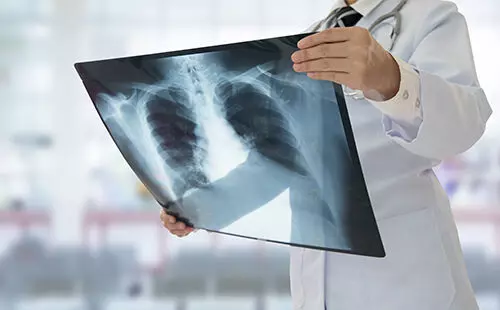Rare case of Left fourth and sixth costovertebral dislocation abutting the aorta: a report

While rib fractures are common in blunt thoracic trauma, dislocations of the costovertebral joints (CVJs) are extremely rare and typically involve the first, eleventh, or twelfth rib.
Natalia Gorelik et al reported a rare case of dislocation of the left fourth and sixth CVJs in a 36-year-old man who was run over by a car. It has been published in “Skeletal radiology” journal.
A 36-year-old man was admitted to the emergency department of a level I trauma center after he was run over by a car at approximately 40 km per hour. On arrival, his level of consciousness was fluctuating, and his vital signs were unstable. He was complaining of chest pain and difficulty breathing and had a respiratory rate of 32 breaths per minute with an oxygen saturation of 88%. Physical examination revealed a lip laceration, a road rash covering 40% of his anterior abdominal surface, a large hematoma on the right flank, and pelvic tenderness. Portable radiographs of the chest and pelvis revealed multiple bilateral displaced rib fractures, a left clavicular fracture, small bilateral pneumothoraces, subcutaneous emphysema, and left lung patchy opacities concerning for pulmonary contusions, as well as multiple pelvic fractures with a left sacroiliac joint diastasis. Bilateral chest tubes were placed, and the patient was intubated. The focused assessment with sonography in trauma (FAST) was positive for intra-abdominal free fluid.
The patient was taken to the operating room for an emergency exploratory laparotomy. He was found to have a large retroperitoneal zone 3 hematoma and a grade 3 splenic injury. A splenectomy and preperitoneal packing were performed. He also underwent angioembolization of bilateral internal iliac arteries. Post-operatively, he was transferred to the intensive care unit. A CT of the head, facial bones, cervical spine, thorax, abdomen, and pelvis obtained later the same day revealed multiple injuries, including bilateral hemopneumothoraces, pneumomediastinum, pulmonary contusions, grade 3 splenic injury, left adrenal hematoma, retroperitoneal hematoma, Morel-Lavallée lesions at bilateral hips, right acromioclavicular joint separation, left sacroiliac joint diastasis, and multiple fractures, namely, at the nasal bones, scapulae, clavicles, ribs, pelvis, right distal radius, and right L1 and bilateral C7 and L5 transverse processes.
Regarding the thoracic cage injuries, on the right, there were fractures at the neck and at the costochondral junction of the first rib, and comminuted fractures of the second through seventh ribs posteriorly. On the left, there were fractures of the head and neck of the first rib; costal cartilages of the first, second, and fourth ribs; costochondral junctions of the fifth and sixth ribs; and body of the second through ninth ribs at more than one site except for the eight rib (flail chest). There was subluxation of the left fourth costotransverse joint and a fracture/dislocation of the left fourth costocentral joint; there was a tiny intra-articular chip fracture of the posterior aspect of the head of the rib. There was also a subluxation of the left sixth costocentral joint. The heads of both the left fourth and sixth ribs abutted the posterior aspect of the proximal descending aorta. These costovertebral joint injuries and their proximity to the aorta were not described on the initial CT report.
The patient underwent multiple subsequent chest CTs for ongoing fever. The last scan performed 54 days post trauma demonstrated persistent costovertebral joints malalignment and no aortic injury. A transverse fracture through the superior endplate of T4 with no significant loss of height or involvement of the posterior wall was occult on the initial CT and became apparent on subsequent CTs. Over the course of his hospitalization, the patient underwent surgical fixation of the pelvic fractures. His recovery was complicated by infarctions at the left posterior inferior cerebellar artery and right posterior cerebral artery territories. The patient was discharged to a rehabilitation center after a 75-day hospitalization.
The authors commented – “In conclusion, this case report presented dislocations of non-consecutive left fourth and sixth CVJs where the rib head abutted the aorta. It documents an unusual presentation of a rare entity and suggests that conservative management may be acceptable in some of these cases. It also raises awareness among radiologists about these injuries, which can be easily overlooked, but are important for the stability of the thoracic spine. Finally, this report emphasizes the association between CVJ dislocations and spine injuries, which can sometimes be occult on initial imaging. Future studies with larger sample sizes and long-term follow-up could help determine the optimal management of CVJ dislocations.”
Further reading:
Left fourth and sixth costovertebral dislocation abutting the aorta
Natalia Gorelik, Dany Croteau et al
Skeletal Radiology (2024) 53:187–192
https://doi.org/10.1007/s00256-023-04415-3



